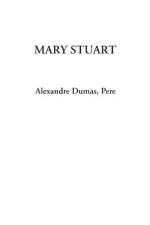“The light!” cried she, “madam, the light!”
At the same time she raised the queen, and with arm outstretched from the window, she showed her the beacon, the eternal symbol of hope, relighted in the midst of this dark night on Kinross hill: there was no mistake possible, not a star was shining in the sky.
“Lord God, I give Thee thanks,” said the queen, falling on her knees and raising her arms to heaven with a gesture of gratitude: “Douglas has escaped, and my friends still keep watch.”
Then, after a fervent prayer, which restored to her a little strength, the queen re-entered her room, and, tired out by her varied successive emotions, she slept an uneasy, agitated sleep, over which the indefatigable Mary Seyton kept watch till daybreak.
As William Douglas had said, from this time forward the queen was a prisoner indeed, and permission to go down into the garden was no longer granted but under the surveillance of two soldiers; but this annoyance seemed to her so unbearable that she preferred to give up the recreation, which, surrounded with such conditions, became a torture. So she shut herself up in her apartments, finding a certain bitter and haughty pleasure in the very excess of her misfortune.
CHAPTER VII
A week after the events we have related, as nine o’clock in the evening had just sounded from the castle bell, and the queen and Mary Seyton were sitting at a table where they were working at their tapestry, a stone thrown from the courtyard passed through the window bars, broke a pane of glass, and fell into the room. The queen’s first idea was to believe it accidental or an insult; but Mary Seyton, turning round, noticed that the stone was wrapped up in a paper: she immediately picked it up. The paper was a letter from George Douglas, conceived in these terms:
“You have commanded me to live, madam: I have obeyed, and your Majesty has been able to tell, from the Kinross light, that your servants continue to watch over you. However, not to raise suspicion, the soldiers collected for that fatal night dispersed at dawn, and will not gather again till a fresh attempt makes their presence necessary. But, alas! to renew this attempt now, when your Majesty’s gaolers are on their guard, would be your ruin. Let them take every precaution, then, madam; let them sleep in security, while we, we, in our devotion, shall go on watching.
“Patience and courage!”
“Brave and loyal heart!” cried Mary, “more constantly devoted to misfortune than others are to prosperity! Yes, I shall have patience and courage, and so long as that light shines I shall still believe in liberty.”
This letter restored to the queen all her former courage: she had means of communication with George through Little Douglas; for no doubt it was he who had thrown that stone. She hastened, in her turn, to write a letter to George, in which she both charged him to express her gratitude to all the lords who had signed the protestation; and begged them, in the name of the fidelity they had sworn to her, not to cool in their devotion, promising them, for her part, to await the result with that patience and courage they asked of her.




